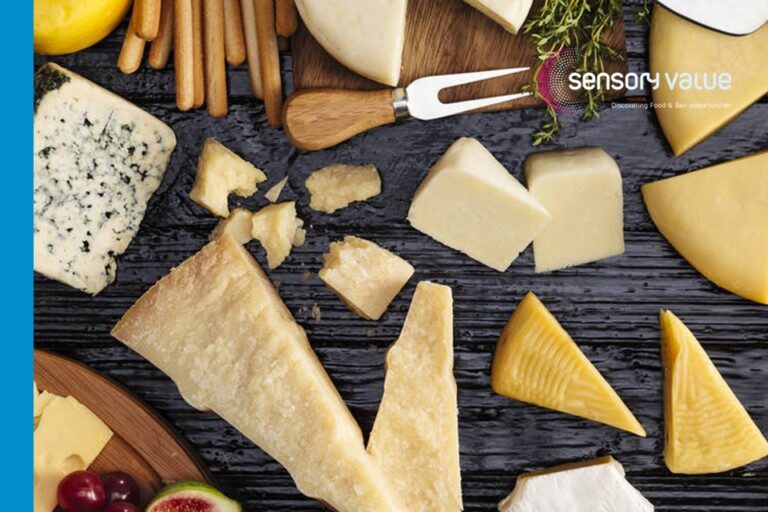Cheese and its distinctive flavours
Cheese is one of those foods that doesn’t admit any middle ground: it is either adored or detested. This division of opinions is even more dramatic in the case of very mature cheeses and varieties with a stronger aroma and flavour. Furthermore, this food has some very unusual characteristics, which have very specific effects in the brain. Why is cheese such a special food?
The five senses and cheese: aroma
One of the reasons why cheese is not a food for everyone is its aroma. Highly aged cheeses and specialties such as Munster, for example, can be too aggressive for people who are sensitive to strong smells. However, it is precisely this same characteristic that makes cheese a real source of pleasure for other people.
The correct way to appreciate the aroma of a cheese is to smell it. In this way, we can identify the family it belongs to. We can talk about the following cheese families depending on the aroma.
- Dairy: containing whey, boiled milk, cream, yogurt or butter.
- Vegetable: with aroma of vegetables, unseasoned wood or hay, for example.
- Floral: violet, rose, honey.
- Fruity: smelling of tropical fruits, apricot, apple, citrus fruits…
- Roasted: chocolate, coffee.
- Spicy: pepper, cloves, cinnamon, nutmeg.
The best way to fully appreciate the aroma of a cheese is to bite on it for a few seconds, while retaining your breath with your mouth closed. Afterwards, you should exhale through the nose in several bursts. In this way, the aroma will reach the pituitary gland, where we will be able to identify its different nuances.
Palatability: the impact of cheese in the mouth
Cheese lovers defend cheese tooth and nail against its detractors. And the fact is that its taste is one of its great plusses. Of course, this taste is not uniform. Fresh cheeses and mild cheeses have a much blander taste than blue cheese, for example. However, they all share one characteristic: palatability. Palatability is the ability of a food to please the palate.
Some people say they are hooked on cheese. This is due to the connection between this food and certain neurochemicals in the brain. Casein, present in milk and therefore also in cheese itself, generates this type of addictive effect. It increases the sense of wellbeing and pleasure. This is not something exclusive to cheese. However, the link established between pleasure and cheese is as strong as that made with chocolate.
In the worst of cases, we may appreciate trigeminal sensations. These are sensations that can seem aggressive, strange or even irritating. With cheese this happens when we notice a metallic, medicine-like or sharp taste, for instance.
The texture of cheese
As with the rest of the senses, the consumer’s attitude to cheese varies according to its texture. Cheeses like Parmesan, for example, are very hard and keep their shape. The sensation when a piece of cheese breaks up in the mouth is incomparable. The crumbliness of aged cheeses is notable, i.e. the ease with which they fracture into little pieces. And it is also one of the features of this type of cheese that its fans enjoy most.
On the other hand, fresh cheeses offer a completely different experience in terms of texture. Fresh cheese is light and it does not crumble because it is very soft. Its very name is an invitation for use in salads. It is also considered healthier than aged cheese because of its lower fat content. And its high moisture content and its colour also play a role. Cream cheeses are perfect for canapés thanks to their spreadability and are also used more and more in children foods. Largely for the same reason.
The visual impact of cheese
As we have seen in other articles, the colour of foods has a direct effect on the way in which consumers perceive them. Not for nothing is it said that we eat with our eyes first. Well, cheese comes in various colours, all of them attractive.
- Cheeses like Cheddar and Mimolette are an attractive orange colour. Traditionally, cows in the USA sometimes used to eat achiote seeds. These are very rich in beta-carotenes, which gave the milk a yellowish tint and the cheese a more intense orange hue. Today the seeds are no longer part of the cows’ diet and the colour is obtained from annatto. This is derived from the same plant and is added during the preparation of the final product. It does not alter the flavour and conserves the traditional appearance of these cheeses.
- Yellow cheese is yellow because of the beta-carotene found in grass. Thus, the more grass cows eat, the yellower the cheese will be. Beta-carotene is very rich in vitamin A.
- White cheese is either fresh cheese or goat cheese. Goats also eat grass but the yellow colour of beta-carotene is not carried through to the cheese. The reason is intriguing: when goats digest grass, they synthesize the beta-carotene and turn it into Vitamin A.
- Blue cheese: Penicillium is the fungus present in blue cheeses that gives them their special colour. This fungus also alters the texture of the cheese and its properties. It is rich in vitamins A and D and those from group B. It has a high calcium content too.
A residual taste or aftertaste appears after finally swallowing the cheese. This is not exactly the same as the taste sensations perceived previously, while the cheese was in the mouth. In fact, completely new aromas and flavours may emerge in the mouth due to this aftertaste. Furthermore, overall persistence must be taken into account, i.e. how long the sensations caused by the cheese last. In some cases it may be more than 30 seconds. A perfect conclusion to the enjoyment of one of your favourite foods after you’ve already eaten it… assuming you like cheese, of course!




Quelque chose à dire ?